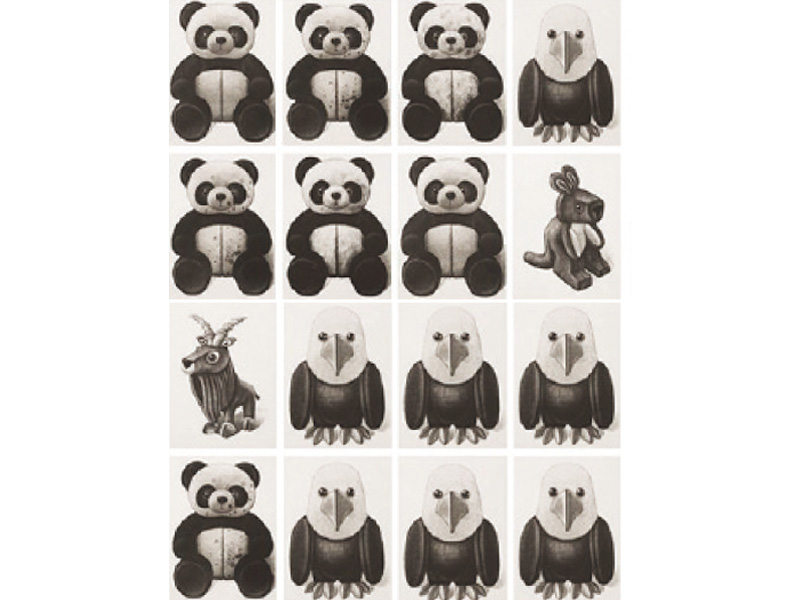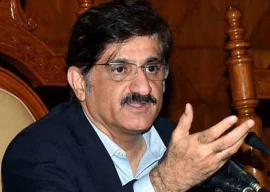
We live in a world that is brimming with stereotypical attitudes. This was a subtle, yet powerful message in Ben Rak’s prints.
Rak’s works are on display at the Koel gallery along with the works of four other artists, Michael Kempson, Roohi Ahmed, Adeeluz Zafar and Abdullah Syed.
Using bobble-head dolls as his subject, Rak has printed a series with the help of silkscreen techniques. One doll wore the garlands and skirt that are typical of Hawaiian Hula girls. There was also an Arab Sheikh wearing the traditional robe and a Japanese girl sporting a traditional kimono with her hair tied up.
The series, which had various cultures portrayed, seemed to communicate with the viewer about how we assign specific traits to a whole culture. There will be Sheikhs who will wear jeans and there will be Japanese girls who will let their hair loose. The prints just make one wonder how prone we are to assuming that all the people from a certain place will look alike.

Another series on display was that of Abdullah Syed, who curated the show over the Internet. His etchings and embossments were more than thought-provoking. The series, titled ‘Enmeshed Etchings’, seemed to depict a kind of hypnotic trance. Embossed and etched on Velin Arches print-making paper, the ‘Enmeshed Black’, the ‘Enmeshed Grey’ and the ‘Enmeshed White’ portrayed a chaotic state of mind in which a person attempts to seek the truth but is unable to find any. The dartboard target serves as a motif in the series to achieve this effect. The target remains largely unachievable in the wake of the circular patterns that divert concentration.
Roohi Ahmed, whose works depicted patterns of stitches, was also quite a thinker. She observed as minimal things as stitches and threads. “I like the leftover pieces of thread that are the spinoffs of stitching,” she said. “Stitching is a contemplative activity for me. I observe pieces of threads and stitches because they allude to a form of a code. To me, these codes are like my unsaid thoughts and unknown story.”
Her minimalistic concentration also focuses on the minor happy moments of life. “I like the little things that people say to me because their meanings affect me greatly,” she said. Her temperament and focus on life is well-expressed in her work titled ‘Seemingly Horizontal’. From a distance, it looked like an electrocardiogram scan, which is a sign of life. But a closer look showed stitches and threads.
Adeeluz Zafar played with the motif of bandages, and his works are a kind of a social commentary. “Bandages can have many connotations,” he said, while speaking to The Express Tribune.

Another interesting idea in his artworks was that the bandaged images were of animals, some of whom had been conjoined within the bandages. With bandages serving as a symbol of healing, the viewer feels as if the prints are a symbolic narration of how we, as humans, are dependent on each other in the process of healing.
Renowned painter Meher Afroz was quite appreciative of all the works. “They [artists] are professionals and the way they have used different printmaking techniques is very strong,” she said. “The presentation is really intricate and minimal, yet it has a strong presence.”
She concluded her note by suggesting that anybody who does not know much about prints should come to see this exhibition. The show is set to continue till September 21.
Pandas, eagles, and other little animals
Using children’s toys as his motif, Australian artist Michael Kempson aimed to advocate strengthening bilateral relations between Australia and Pakistan and other Asian countries.
“Australia is not part of Europe or the West,” he said. “It comes under the Asia-Pacific region. We were a colony of the British. Yet I believe we have more to share with our Asian counterparts.”
He commented on the complexities of geopolitics in his works. “You see, it’s a complex system,” he said. “The relations between larger countries, like the United States and China, have an impact on their smaller allies, like Australia and Pakistan.”
He attempted to express this idea in his print titled ‘Presents of presence’ in expert fashion. In the picture, a giant panda, that is the national animal of China, overshadowed a small koala, which belongs to Australia.
He focused on symbols of Australia and other countries in his prints. A whole wall was dedicated to his variety, which included many prints of pandas, as many eagles (denoting the US), a kangaroo (a symbol of Australia) and a markhor (the national animal of Pakistan). The way the two little animals (kangaroo and markhor) were surrounded by the numerous bigger pictures of pandas and eagles was an apt representation of how the stronger countries are capable of affecting the smaller ones with their power and decisions.
Published in The Express Tribune, September 14th, 2014.



1732626034-0/BeFunky-collage-(92)1732626034-0-165x106.webp)













COMMENTS
Comments are moderated and generally will be posted if they are on-topic and not abusive.
For more information, please see our Comments FAQ